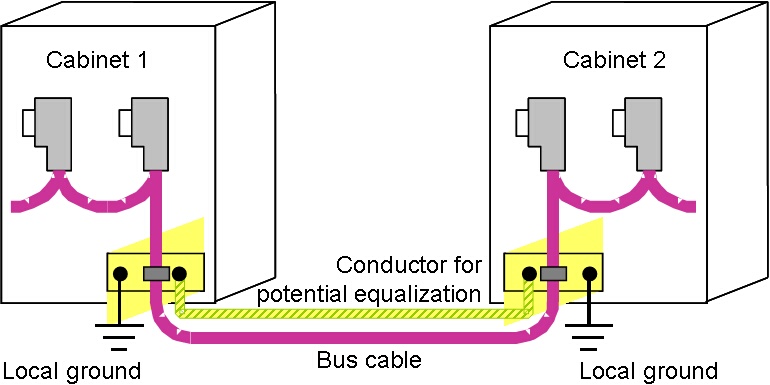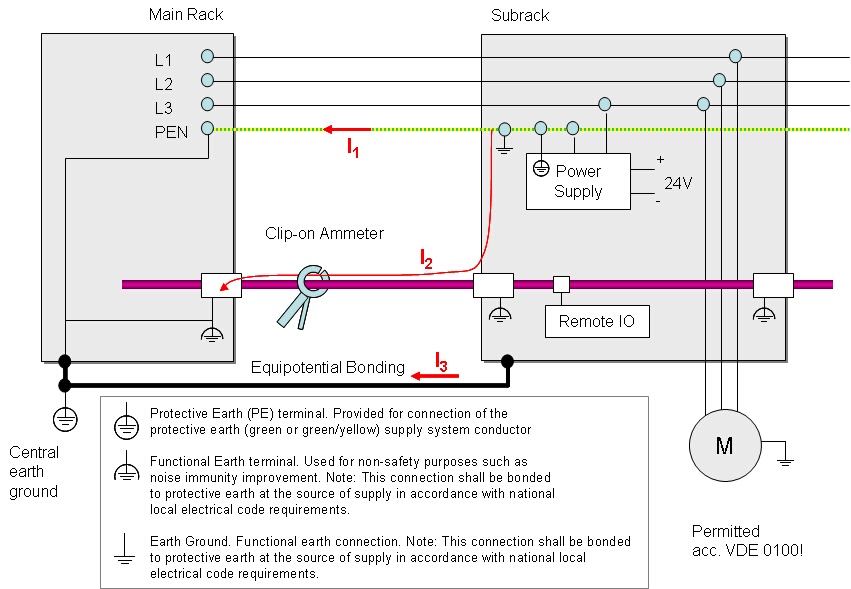
PROFIBUS Manual
To allow the shield to screen out high frequency interference effectively, it must be earthed at both ends. In special installations, potential differences may arise between different locations within a single installation, leading to potential equalization currents along the length of the cable shield. Equalization currents of this type should always be strictly avoided, because they can lead to interference couplings. Earth problems arise if:
a)The bus cable covers a large area or bridges a large distance
b)The electrical energy comes from different sources (e.g. several substations)
c)Large electrical outputs are consumed (e.g. by welding robots, large drives, etc.)
One solution is to install an additional potential equalization cable between the individual potentials. The potential equalization line should also be capable of diverting large currents (a 16 mm2 profile is not unusual). Stranded cable with a good surface should be used, so that even high frequency currents can be efficiently diverted.

Installation of a conductor for potential equalization
Potential equalization lines should be laid parallel to the bus cable and as near as possible, so that the area between the two cables is as small as possible.
IMPORTANT: The shield of a bus cable should NEVER be used for potential equalization!

PE-Wiring (5-core Cable = TN-S)
In the case of PE wiring (5-core = TN-S) the neutral conductor (N) and protective earth (PE) are kept rigorously separate. Even with an asymmetric load, no current flows to earth and the PROFIBUS cable shield therefore remains free of current. This can be easily verified with a current probe. Current on the shield should not exceed a value of a few milliamps. In practice, over 30 mA of current on the shield is viewed as problematic. Current in excess of 300 mA can heat up the cable unduly and be the cause of fire damage.

PEN Wiring (4-core Cable = TN-C)
In the case of PEN wiring (4-core = TN-C) under an asymmetric load, the equalizing current I1 will flow on the common PEN conductor because it will seek the path of least resistance. Part of the current I3 can therefore also be diverted through the earth. This too may involve a not inconsiderable part I2 being diverted through the PROFIBUS shield. This can be confirmed with a simple current probe.
To remedy this, it is advisable to make part of this connection with a FO cable, or else use a repeater to isolate the shield electrically.
Alternatively, the standards also suggest a capacitive earth, especially for explosion-proof installations. This involves connecting the shield with an RC combination. Its small capacity (< 10 nF) diverts high frequency interference but has a high impedance effect for the mains frequency (50 or 60Hz), thereby preventing equalizing currents over the shield. A high impedance resistor connected in parallel will prevent the capacity from charging itself up with DC voltage. This capacitive earth can be implemented at one or all ends of a PROFIBUS cable. Here too a current probe can be used to check correct function.

Capacitive grounding of the schield
